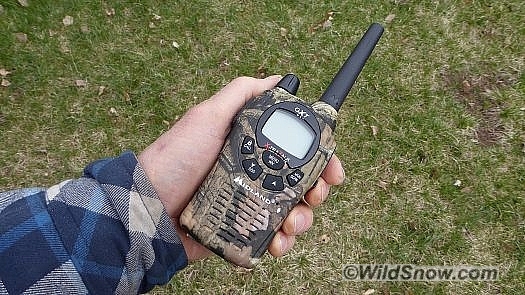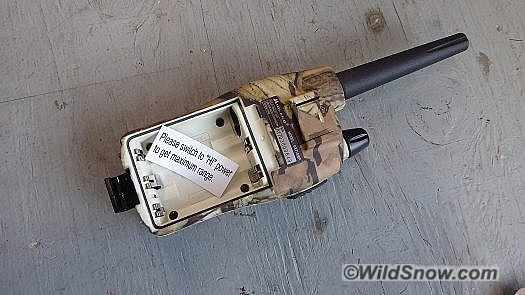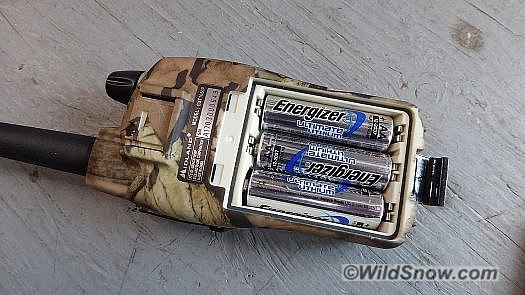With the flux of consumer “blister pack” radio rules and standards in somewhat of a phase change, I was holding off on reviews like this. Then after studying the rule changes, I realized that current models might be worth acquiring.
First, consider the Midland X-Talker (Amazon link to right). These little guys have been around for a while — we’ve got a set that’s been in play for a couple of seasons. They’re more reliable than you’d expect for around $70 a pair, with the full 22 channel (frequency) contingent we’ve come to expect. In this case, you’re looking at a radio that in performance conforms to the new FCC rules, as the maximum power of 2 watts is available on all but channels 8 – 14, which are preset to a half watt. While the enclosed manual for our X-Talker test units had not been updated to reflect new FCC rules, with the channels configured as they are the radio is an “FRS” unit and does not require a license.
Thing is, blister pack radio prices are all over the map. As of my last look, for less money you could get a better radio than the X-Talker. Don’t ask me why. In any case, we’ll skip an in depth review of the X-Talker as it’s quite similar to better Midland models such as the X-tra Talk, which we review below, and today on Amazon does cost less.
So, consider the X-tra Talk GXT pair we’re testing. Rather than 2 watts maxium power, this rig goes to 5 watts on all but channels 8-14. Moreover a longer antenna and presumably more robust electronics combine with added power for much better range. That’s significant, as these sorts of radios when run at lower watts, e.g., the aforementioned X-Talker, simply do not carry well in a mountain backcountry environment. Here is the important part: With the new rules, it appears that radios such as X-tra Talk, yielding the standard 22 channels including lower power 8 through 14, will change in name only, and be called “GMRS” instead of “FRS/GMRS.”
Okay guys and gals, it’s clear the X-tra Talk is what we’d recommend. How about some review action in the WildSnow tradition? First, let’s get the usual gimmick features out of the way. Perhaps one of the reasons blister pack radios are considered to be toys is settings such as “Call Alert,” which the X-tra Talk does have. What this utterly useless and downright annoying feature does is provide a button you can push to send a variety of amusing sounds to your friends, for example: cougar, duck, crow, wolf and turkey. While I did consider using the turkey sound (translation: “Hi guys, it’s Lou the turkey”), it is a joke. Actually, it’s a bad joke since even with the keypad locked and the radio set to “Silent Mode,” pressing the “Call” button will still transmit some variety of annoying sound — and the button is sensitive to accidental activation. Only solution, grab a razor blade and cut the “Call” button down flush with the radio face, that way it is unlikely to be accidentally pressed, but can still be used to activate the “Lock” function.
The “SOS Siren” is another potentially annoying feature (you’ll wonder who thinks this stuff up). Press the SOS button and yes Virginia you too can pretend you’re the county sheriff racing to a crime scene. Thankfully, once the keypad is locked (and you should always lock) the SOS button is disabled, though it could also be trimmed down if so desired.
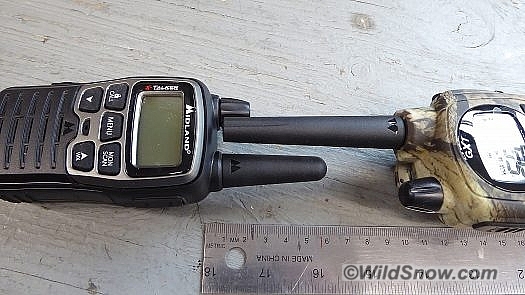
X-tra Talk antenna is significantly longer than X-talker. This could be a big deal in terms of range performance. Moreover, the body of the X-tra is longer. The radio chassis forms part of the antenna this being slightly longer could be significant as well.
Moving along, a variety of good useful X-tra Talk features makes up for the gimmicks. Perhaps most importantly, a “Silent Mode” setting stops all keypad noise (though you still have to go through the menus to disable dumb stuff such as the incredibly annoying “roger beep”). Why electronics designers think we need default keypad sounds is beyond me. Perhaps they’re helping us feel empowered by technology now that we’re abandoned by Facebook? Okay okay, to be fair it’s sometimes good to get audio feedback when you’re button pressing. So having this feature, with the ability to disable, fine. The other top feature of the X-tra Talk is of course the high power setting. This is easily set by pressing the Menu key until the “Pr” option comes up, then pressing the keypad up arrow key to get that wonderful battery depleting little “H” showing on the LCD. As with all FRS/GMRS radios, anything but low half watt power in unavailable for channels 8 – 14.
What else do we like? We had no problem getting our local NOAA weather on one of the 10 available weather channels. While complicated to set up, a “dual watch” feature is available for situations where you’re tracking different people on different channels. Likewise, a quick press of the “Scan” button begins ripping through all 22 channels plus the extra Midland specific channels. Speaking of which, you’ll notice these radios are advertised as having “50 channels!” Beyond the standard 22 channels/frequencies of any blister pack radio, the extra “channels” are simply preset combinations of the standard 22 channels plus privacy code. I suppose that could be useful, but it’s misleading, and only Midland radios have the presets. You can’t ask a person with another brand radio to “switch to 48,” they don’t have it.
The X-tra talk GXT series units are water resistant to standard JIS4. Meaning you shouldn’t dangle the radio from your pack strap during a downpour, but you wont have trouble during normal winter activities so long as you make some effort to protect from excessive moisture. For example, storing in a pocket or backpack, or enclosing in a ziplock. Available shoulder mics, specifically the Midland AVPH10 are said to be water resistant (see below). We’ve tested and have not had any trouble using the AVPH10 during Colorado winter snowstorms, but in the case of wet snow or rain I suspect the mic could eventually be compromised unless it’s stored with a modicum of protection. Surprisingly, a shoulder mic costs more than the radio!
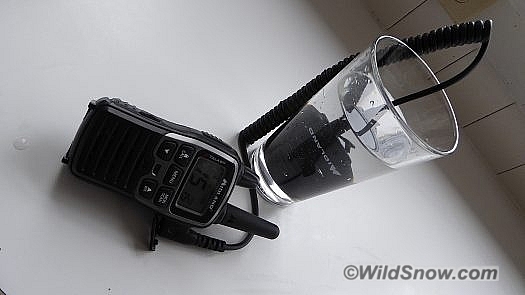
Like I said, this is WildSnow, so we went for it with the AVPH10 shoulder mic. After 10 minutes in a glass of water I could still transmit while immersed, and hear a transmission when it was out of the drink. While this certainly proves the mic is “water resistant,” it is not sealed in any way, was full of water as soon as I immersed, and I’m sure would soon corrode to failure after much water ingress. Upon disassembly, it was obvious the big problem with water resistance is the speaker grill being covered with nothing more than porous felt. If you had the mic on your shoulder in the rain, it would be only minutes before moisture began accumulating on the internals. Ziplock is probably the solution, or stow away during wet snow or rain.
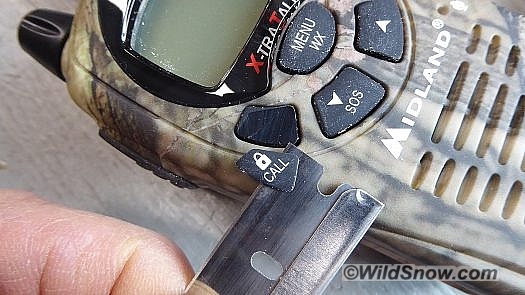
We’ve been trimming the Midland CALL button for years. I guess they didn’t get the call. Whatever, easy solution for this pesky thing and also defends against the LOCK function being accidentally activated.
Sadly you can’t simply plug the X-tra Talk into your automobile 12 volt socket, though it does come with a 12v adapter for the drop-in charger. A rechargeable battery pack is included with the rig, and is of some concern being a nickle-metal-hydride at a paltry 700 mAh. As comparison, you can run the X-tra on 4 AA batteries: use lithiums and you get 3,000 mAh for just one battery, or 12,000 for four! Indeed, if there is any weak point of the X-tra Talk it would be the measly OEM battery. As with any radio you depend on for personal safety, you’d probably want to have spare power for the X-tra Talk. Four AA lithium batteries in your repair kit are the ticket.
Conclusion: If you’re willing to fiddle with various noise settings and carry a set of spare batteries, we recommend the X-tra Talk Midland. Be aware that available shoulder mics are surprisingly expensive and don’t appear to be entirely waterproof. For intermittent use you don’t need a shoulder mic, but they’re a must for constant radio use during activities such as ski touring. The X-tra does come with headsets, useful for activities such as snowmobiling but in our experience too fiddly and prone to tangle during backcountry skiing. Note, according to new FCC rules the use of channels 1-7 and 16-22 require a license at power over 2 watts (which would be the “H” setting on this rig). Ignoring the licence requirement is common (and in my opinion fine if you don’t use the high power option other than in emergencies), but it’s probably best to acquire a licence (browse to fcc.gov, search for form 605, download the 29 page PDF).
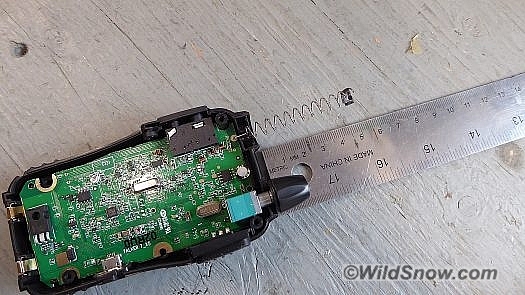
Teardown time in the Rockies? X-Talker internals. Nothing particularly wrong with antenna being a chunk of coiled wire, but the longer the better.
One more thing. If you find yourself frequently using FRS/GMRS radios, you might want a “mobile” rig you can mount in your vehicle, with a decent external upgradeable antenna. Unfortunately, while this sort of thing is available, once the antenna is detachable FCC has not up to this time allowed the inclusion of the lower power channels 8-14. Thus, unless you and your friends are diligent about not using those channels (even though you might have them in your handhelds), such mobile units are next to useless. Instead, you’re better off using a good quality handheld that does include 8-14, and if range is a problem step out of the vehicle or hold the radio out the window. We could not interpret the new rules as to changing this in any way, but you never know.
WildSnow.com publisher emeritus and founder Lou (Louis Dawson) has a 50+ years career in climbing, backcountry skiing and ski mountaineering. He was the first person in history to ski down all 54 Colorado 14,000-foot peaks, has authored numerous books about about backcountry skiing, and has skied from the summit of Denali in Alaska, North America’s highest mountain.

